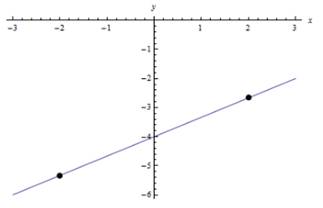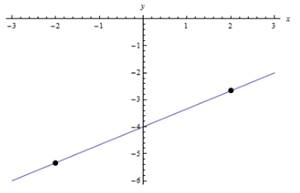
Concept explainers
To graph: the equation,
Answer to Problem 20E

Explanation of Solution
Given information:
Calculation:
The above equation is already in slope intercept form. Now find value of y , by substituting different value of x.
Put
So, the first coordinate is
Put
So, the second coordinate is
Now, graph the line straight to these points, and it will be formed as follows:

Chapter 1 Solutions
Advanced Mathematical Concepts: Precalculus with Applications, Student Edition
Additional Math Textbook Solutions
Calculus: Early Transcendentals (2nd Edition)
Algebra and Trigonometry (6th Edition)
Thinking Mathematically (6th Edition)
College Algebra with Modeling & Visualization (5th Edition)
A First Course in Probability (10th Edition)
University Calculus: Early Transcendentals (4th Edition)
- For number 9 The answer is A Could you show me howarrow_forwardThe answer is B, Could you please show the steps to obtain the answerarrow_forward2. Suppose that U(x, y, z) = x² + y²+ z² represents the temperature of a 3-dimensional solid object at any point (x, y, z). Then F(x, y, z) = -KVU (x, y, z) represents the heat flow at (x, y, z) where K > 0 is called the conductivity constant and the negative sign indicates that the heat moves from higher temperature region into lower temperature region. Answer the following questions. (A) [90%] Compute the inward heat flux (i.e., the inward flux of F) across the surface z = 1 - x² - y². (B) [10%] Use the differential operator(s) to determine if the heat flow is rotational or irrotational.arrow_forward
- Could you show why the answer is B Using polar coordinates and the area formulaarrow_forward1. The parametric equations x = u, y = u cos v, z = usin v, with Ou≤ 2, 0 ≤ v ≤ 2π represent the cone that is obtained by revolving (about x-axis) the line y = x (for 0 ≤ x ≤2) in the xy-plane. Answer the following questions. (A) [50%] Sketch the cone and compute its surface area, which is given by dS = [ | Ər Or ди მა × du dv with S being the cone surface and D being the projection of S on the uv-plane. (B) [50%] Suppose that the density of the thin cone is σ(x, y, z) = 0.25x gr/cm². Compute the total mass of the cone.arrow_forwardThe value of sin (2V · F) at x = 3, y = 3, z = −4, where F -0.592 -0.724 0.661 -0.113 -0.822 -0.313 0.171 0.427 = (-2x² + -4,2yz − x − 3, −5xz - 2yz), isarrow_forward
 Calculus: Early TranscendentalsCalculusISBN:9781285741550Author:James StewartPublisher:Cengage Learning
Calculus: Early TranscendentalsCalculusISBN:9781285741550Author:James StewartPublisher:Cengage Learning Thomas' Calculus (14th Edition)CalculusISBN:9780134438986Author:Joel R. Hass, Christopher E. Heil, Maurice D. WeirPublisher:PEARSON
Thomas' Calculus (14th Edition)CalculusISBN:9780134438986Author:Joel R. Hass, Christopher E. Heil, Maurice D. WeirPublisher:PEARSON Calculus: Early Transcendentals (3rd Edition)CalculusISBN:9780134763644Author:William L. Briggs, Lyle Cochran, Bernard Gillett, Eric SchulzPublisher:PEARSON
Calculus: Early Transcendentals (3rd Edition)CalculusISBN:9780134763644Author:William L. Briggs, Lyle Cochran, Bernard Gillett, Eric SchulzPublisher:PEARSON Calculus: Early TranscendentalsCalculusISBN:9781319050740Author:Jon Rogawski, Colin Adams, Robert FranzosaPublisher:W. H. Freeman
Calculus: Early TranscendentalsCalculusISBN:9781319050740Author:Jon Rogawski, Colin Adams, Robert FranzosaPublisher:W. H. Freeman
 Calculus: Early Transcendental FunctionsCalculusISBN:9781337552516Author:Ron Larson, Bruce H. EdwardsPublisher:Cengage Learning
Calculus: Early Transcendental FunctionsCalculusISBN:9781337552516Author:Ron Larson, Bruce H. EdwardsPublisher:Cengage Learning





